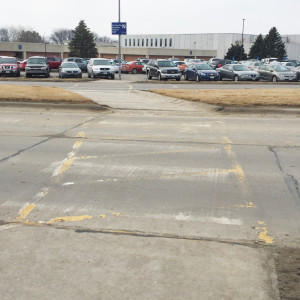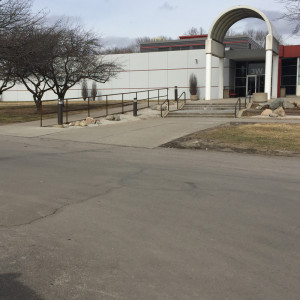During the Fall 2015 semester there were 17 car accidents reported to school security officers that involved students in and around the DMACC Ankeny campus.
In 2016, there have been three., one of which was an accident involving Professor Lisa Ossian. On February 11, 2016 at 9:30 a.m., Ossian was hit by a car while crossing the walkway into Building 3.
Professor Ossian, a full-time history professor who has worked on the Ankeny campus for 11 years, had minor injuries, but it could have been worse if she had not been paying attention.
“I got out of the way… if I had been six inches over he would have just hit me. I would have flipped over or under the car.” Ossian said.

Professor Lisa Ossian twisted her ankle when a car bumped into her in the Ankeny Campus Parking lot.
Instead, the accident resulted in her twisting her ankle, from which she quickly recovered.
Ossian said the driver wasn’t stopping because he was texting his mother. He didn’t even realize he hit her with his car. She approached him after, but he wouldn’t talk to her, which was when she contacted Ankeny police and filed a report.
Because she was helped by an eyewitness, Ossian urges, “If people see something they need to volunteer.”
When she filed her report she had the young man’s license plate number, an eyewitness who corroborated the story, and as she stated “you could see where the car had swiped me and where my handprint was on the car.”
While DMACC’s charge for a moving violation is $50, this was a potential criminal offense because the driver did not stop or help Ossian. He could have gone to jail. Instead, the incident is on his insurance record and his rates will increase.
Students need to be aware when walking through the parking lot because, as Ossian points out, “[The Ankeny Campus] parking lot doesn’t have any designated crosswalks or sidewalks. It’s not a clearly marked parking lot.”
Parking on campus is enforced by Terry Harrison, the security supervisor, and his team of 23 security officers who handle all security issues on campus.
They received Ossian’s report about the hit and run and followed up to complete a report.
Harrison said, “If someone has an accident, we would hope that they would contact us at the time of the incident so that we could come down there and get our information.”
He wants every student on campus to have security’s phone number in their contact list which is 515-964-6500.
The number one parking complaint Harrison’s office receives is, “There’s no place to park.”
He refutes this claim stating that, “We’ve never filled up, ever, all of our parking.”
Ned Miller the executive director, Physical Plant reiterates Harrison’s statement saying that “even with lots closed due to construction all of the parking lots are never filled.” Students may have to park in A or J lot and walk farther, but there are always available parking spaces.
The second most common complaint is, “These drivers are not paying attention.”
Austin Taylor, 22, from Des Moines, drops his girlfriend off at DMACC. He said “I noticed a lot of heads down either looking at their phones or changing the radio station and a lot of people going way too fast in the parking lot. A normal parking lot speed is about 5-10 mph. These people were going at least 15-25mph.”
Taylor’s concerns about the parking lot are echoed by Eddie Brandes, 22. He said that two weeks ago while driving through the Building 2 lot another car “came cutting around the corner too fast, flew by, and almost took off my mirror.” He slammed on his brakes so the driver didn’t hit him.
This was after an episode earlier this semester when Brandes was getting out of his car and walking into the library. As he was crossing, he saw a car that was going too fast. He feared that he was going to be hit when, as he said, “it kept going and did not slow down.”

Crosswalks and speed bumps are scheduled to be repainted as weather allows.
Gabrielle McPhereson, 20, noticed that when she comes to school at 10 a.m. the parking lot is always busy. She said she is concerned about the speeding drivers.
So what is the speed limit in the parking lots? Brandes guesses 15 mph. Holly Byrkett, 20, and Noah Nordengren,18, believe the speed limit in the DMACC parking lot is 20-25 mph. McPhereson thinks the speed limit in our lot is 15 mph because “That’s the normal parking lot speed.”
Along DMACC Blvd. the posted speed limit is 25 mph. There are no signs designating DMACC parking lot speed. The parking lot speed is not listed under Parking Regulations in the student handbook or in the Security Brochure given to students at orientation. The only mention of the parking lot speed was found in the “DMACC Parking and Traffic Regulations” brochure posted online.
In that document it states “The maximum speed limit in all parking areas is 10 mph.”
Harrison explains, “If we put up a sign for every violation we would have signs on every poll, every tree, walking into every building. It would be signage overload.”
Miller agrees and adds that unfortunately some “people don’t pay attention to the 25 mph signs on DMACC Blvd.”

Campus regulations posted at each of the three campus entrances.
At each of the three campus entrances there is a set of 4 signs that state specific campus regulations. On DMACC Blvd. there are “Stop,” “Speed Limit 25,” and “Stop for pedestrians” signs. These signs are sometimes near speed bumps and crosswalks and are sometimes placed far away
from them.
The fading of the paint is from salt, driving, traffic and weather. Miller explained that 100 percent of the crosswalks were painted in the fall and they will all be repainted as soon as weather allows. His crew is also working to repair potholes as soon as possible.
To address signage issues, he said DMACC is having a traffic study done by a traffic engineer that will include speed limits. As part of this traffic study, more speed bumps will be considered which should improve pedestrian safety on DMACC Blvd.
“If there are no 10 mph speed limit signs anywhere in our parking lots I think you’ve already made to me a pretty good case that [they] should be considered,” Miller said.
In addition to posted parking lot speed limits, Ossian suggests more clearly marked walking paths would improve student safety in the parking lots. All five students interviewed suggested that adding speed bumps in the parking lots (not just on DMACC Blvd.) would help.

This is the parking lot area in front of Building 3 where Professor Ossian was crossing. There are no markings on the pavement to warn drivers to slow down or to guide pedestrians who are crossing.
However, this class of students will not get to enjoy these safety upgrades. Miller said he “have a lot planned for 2016 because the trucks for the construction projects are just tearing up our roads.”
He said “[DMACC] has another year of our roads being ‘need improvement’ and we know that and it is in the long range plan.”
The speed limits, traffic signs, and new speed bumps will be implemented in 2017 after the completion of the construction.
Today, speeding and distracted driving is still a problem in the Ankeny campus parking lots. During a 15-minute window Friday May 4, 9 – 9:15 a.m., students were observed driving into parking lot L in front of Building 3. Out of 30 cars, three drivers were texting and three drivers were wearing ear buds. Both texting and blocking outside noise while driving are considered distracted driving.
Also, most of the cars coming into lot L made no attempt to slow down from DMACC Blvd. Almost all 30 cars were driving faster than 10 mph in the parking lot. Harrison’s security team can issue citations for speeding in the parking lot when they see it happen in person or on the surveillance camera system.
“We get the license plate number and then we will backtrack it. We will check the video and issue a citation,” explains Harrison. Measures are in place to handle the problem of speeding in the parking lots.
Students said they want campus security to enforce parking lot speed limits. However, both Miller and Harrison said “’students going too fast in the parking lots is not a regular complaint the security office receives.”
Harrison said, “When we see a problem and it gets specific, then we address it.”
Miller reiterated, “When people complain, we always listen. We don’t just ignore that kind of thing.”
According to Harrison and Miller, if students voice their concerns about speeding in the parking lot, it will be addressed.
While waiting for parking lot improvements, there are measures students can take to protect themselves. Students can call security to report speeding drivers because as Miller points out, “I’ve got to be convinced that putting up more signs is going to make it better.”
Harrison also suggests students “pay attention to distracted driving. Put the phone down. Turn the music off. People can pop out in a second. A vehicle backing up might not have back up lights. Slow down!”
Miller echoes Ossian and Harrison when he suggests, “One single thing is to put cell phones away when walking and driving. Don’t depend on the other person (driving or walking) to watch out for you.”





Comments